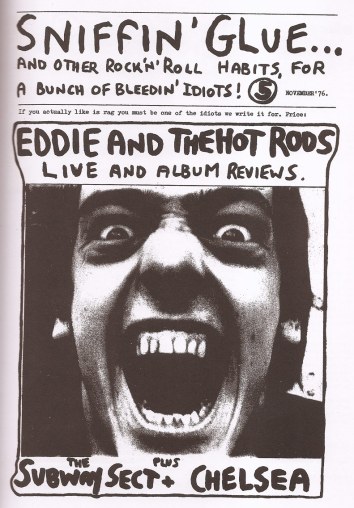Analyse an image from street press- ie posters, zines, street art, etc that is related to a subcultural group/political or ideological position. Use relevant course readings and further research to develop your analysis.
Written by Anhkim Tran
Punk is a subculture group that emerged in 1976. The punks produced and developed their own literature, music and fanzines. Founded by Mark Perry, Sniffin’ Glue was Britain’s first fanzine that embodied the punk subculture. The title of that fanzine was taken from the title of a Ramones song called “Now I Wanna Sniff Some Glue”. While mainstream media could not speak for punks, they founded a way to express themselves through fanzines. Their fanzines were distinct and shocking, which fully expressed the punk’s rebellion against established forms of consumption. 1
Mark Perry’s development of the first Sniffin’ Glue issue started in his bedroom with a children’s typewriter and a felt-tip pen, using every day tools that were readily available. “I just thought it would be a one-off. I knew when I took it to the shop there was a good chance they’d laugh at me, but instead they said, how many have you got? I think my girlfriend had done 20 on the photocopier at her work and they bought the lot off me. Then they advanced me some money to get more printed.” (Mark Perry quoted in Q Magazine April 2002). The do-it-yourself aesthetic of the fanzine was punk form since it was against society’s expectations on how design and music should be. The punks aimed to start a different culture and diverging from the parent culture. Through fanzines, the punks also wanted to encourage others to start their own fanzines instead of consuming what is already being made. 2
The image below is the cover of the Sniffin’ Glue fanzine, which uses a DIY aesthetic with handwritten words and a photograph of a man with an intense expression. The aesthetic of this fanzine alludes to the punk’s reaction against the modern world by being chaotic, unprofessional and ungrammatical instead of following design rules and expectations paved out by modernism. This method gave punks a voice in society as it effectively captures the viewer’s attention though evoking shock, particularly in the use of sexual, swear words or provoking images. In this case, the man’s expression is enough to engage and draw the viewer into the world of punk. The chaotic design of the fanzine contrasts with professional-looking publications and the fanzine can also be cheaply produced. With the rise of record stores and labels, the DIY method gave punks a space to express their ideas, reinforcing their radical political view that made them distinct from society.
Cover, Sniffin Glue Nr. 5, November, 1976, London

- Teal Triggs, “Scissors and Glue: Punk Fanzines and the Creation of a DIY Aesthetic,”Journal of Design History 19, no.1 (2006): 70.
- British Library, “Punk Fanzines,” Learning Dreamers and Dissenters,accessed March 25 2017, http://www.bl.uk/learning/histcitizen/21cc/counterculture/doityourself/punkfanzines/punkfanzines.html.